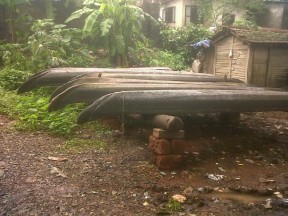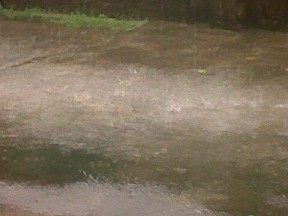Like most people, I love watching the rains. A nice downpour is the time to sit with a hot cup of chai , listen to some lovely music and unwind. Who hasn’t gladly put off chores just because it was raining? So when I heard I had to travel to Calicut in Kerala during the monsoons, I was chuffed.
As expected, the rains had started by the time I reached there. Despite having stayed there while I was very young, I had forgotten the beauty of the place when it was drenched in the monsoons. Each tree, house, and road was soaking in the cleansing showers.
And when it rains in Kerala, it doesn’t just, ‘pitter patter.’ Sheets of lukewarm water descend from the heavens for hours without stopping. And you can just watch the beauty of it it all, in awe. And marvel at the various tints of glistening green leaves on the trees and plants and at the rains lashing down on the Arabian Sea. Grey sky merging with the steel grey water.
My uncle and aunt smiled at my joy in the rain but listened to me silently and unresponsively. Something which I put down to them being “older and hence less appreciative.” In the next few days however, it dawned on me that everyone I seem to bump into regardless of age or sex had the same indulgent smile when I enthused about the rains.
The house-help Nirmala looked at me with bewilderment as I was taking photographs of the rain and asked before donning her rubber chappals, pulling up the hem of her synthetic sari, picking up her huge umbrella and leaving for the day, “Why are you taking pictures of something as ordinary as rain?”
It is then I realised. For people living in Kerala, rain is just a part of life, like the sun rising and setting every day. Come torrential rain or a regular downpour, life goes on–children go to school, offices function, people go out for a meal or a movie…it’s just another day. The key is to adapt. Synthetic saris and umbrellas during the rains and crisp starched cotton mundus and umbrellas during the sun and heat.
Small glitches like a tree falling on an electricity line, or a water-logged area are treated with a resigned casualness. My visit to Kerala was intended mainly to meet up with some artisans in Beypore, 30 kilometres from Calicut. My contact there, an elderly gentleman Mr Pankajakshan called me up the day after I arrived asking me whether we can shift the meeting by “four-five days,” as heavy rains had left the connecting bridge submerged.
I asked him whether he and his family were alright in Beypore and whether they were cut off. “Of course I am fine, nothing happened to me, it’s the bridge that sunk,” was his answer. He went on to assure me that he would make sure that I would meet the artisans even if the bridge remained inaccessible by the end of the week. “How?” I asked. “I will arrange a boat, just make sure you wear rubber chappals and carry an umbrella,” he said. It was as simple as that. Mr Pankajakshan, mind you, was not some rustic villager used to rowing his way around. He travelled in his swanky cars when the bridge wasn’t submerged and in little boats when it was!
I was half hoping that the bridge would stay sunk so that I can have my adventurous boat trip, but the authorities managed to control the water flow. “It’s not a fancy houseboat, it’s a regular vanji, a small boat that people all over the state use,” my aunt explained seeing the disappointment on my face.
My touristyness seemed to be a great source of joy for them and their friends. My stories of sitting with a cup of tea, bunking a movie, rescheduling work and tales of friends not sending their kids to school if the rains were “heavy” in Bangalore were received with much laughter.
“If that were the case here, all of us would have been illiterate,” my uncle guffawed.
He was right. On an average, out of 365 days, it has been reported that Kerala gets rain for 120-140 days. The heavens open up and the state gets around 3200 ml on an average per year, thrice that of the national average.
Said to have almost the same climatic conditions as the Amazonian belt, the soil absorbs the rainwater. The rains have resulted in the formation of lakes, rivers and backwaters across the state. Traditional architectural styles ensure that homes don’t get water logged.
But climatic changes, negligence on the part of civic bodies and a blatant disregard for anything traditional have affected this state as well.
Incidents of flooding because of illegal reclamation of wetlands, and poor city planning have started to dot the newspapers these recent years. Summertime even sees droughts in some parts of the state. There have been ominous forecasts by environmentalists on how rainfall has diminished.
But for the people who live there, all this is just some day in the far future. Today is about living life the simple way, mending broken umbrellas and buying the latest ‘nano’ umbrellas. And just shrugging and going on.
Supriya Unni has been a media professional and writer for over 15 years and enjoys life and the rains without cynicism.








Brings back some memories and well written Supriya. I was just remarking to a friend the other day as to how the rains in Bangalore are so very different to those in Kerala. Anyway, nice to connect again. I especially enjoyed Mr Pankajakshan’s nonchalance to the rain and your appointment. That’s the essence of Kerala for you right there.
Well written indeed.